Greater Adjutant Profile
This bird has been described as having a “grotesque elegance” and that’s entirely appropriate. When it soars overhead, its wings can block out the sun, and when coming into land, it sets its enormous mass, including a foot-long beak, down delicately on the sand.
On closer inspection, sitting on top of its bald, dermatitic face, is a piercing blue eye with long lashes, that when blinked, reveals a creature far more knowing and much cuter than you would expect from something so ugly.
This is the greater adjutant, one of the world’s largest and most misunderstood birds. It’s a member of the stork family, and its genus includes the lesser adjutant, and the marabou stork.
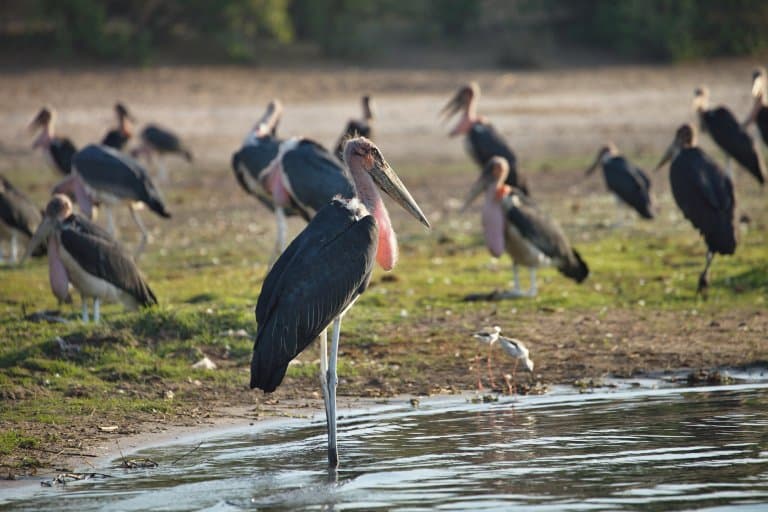
Greater Adjutant Facts Overview
| Habitat: | Tropical wetlands for breeding, commonly feeding in urban areas |
| Location: | India, Cambodia, Bangladesh, Nepal, Thailand, Viet Nam |
| Lifespan: | 43 years in captivity |
| Size: | Up to 150cm (4’9”) tall, wingspan 2.5m (8’2”) |
| Weight: | More than 8kg (18lb) |
| Colour: | Grey back, white or grey belly, with a white ruff |
| Diet: | Generalist scavengers, mostly of carrion, but can eat fish |
| Predators: | Only humans |
| Top Speed: | Unknown |
| No. of Species: | 1 |
| Conservation Status: | Endangered (IUCN) |
Once common across Southern and Southeast Asia, the Greater Adjutant is now wiped out in the majority of their range, and breeding populations now occupy only a single state in India and part of Northeastern Cambodia.
These storks are enormous. They’re only slightly smaller than their African Maribou cousins and often stand as tall as the average Cambodian woman at around 1.5m.
They’re certainly ugly, but they’re also agile, humble, and intelligent, and, as usual, they have a significant and overlooked role in the ecosystem.
They spend their time soaring high in the termals scavenging. They mainly feed on carrion and offal, but will occassionally eat frogs, reptiles, rodents, birds and fish.
Sadly, they are endangered with the population size estimated to be below 1,000 individuls in 2008.
Interesting Greater Adjutant Facts
1. They’ll eat anything
When you see a bird with a bald head, it can mean one of only a handful of things. Either it has some kind of infection, or it’s being bullied by its peers, or it likes to stick its head into things that you wouldn’t want to get on your coat.
Vultures are well known for going up the bum to find the easy entrance to a recently deceased mammal, and this adequately explains why they don’t want feathers on their heads. Adjutants are not fussier about where they bury their faces either.
Adjutants can even make bin chickens look good. This is a bird whose sense of decorum abandoned it long before records began; they’ll happily delve into a discarded pile of human waste for lunch, despite the fact that they’re more than capable of catching frogs and even large fish in cleaner pastures.
But they’re not that bothered, and like other notorious scavengers, have an incredible resilience to a lot of the things that would quickly kill one of us.
These are the epitome of generalist feeders, and this is certainly the, and you can’t help but kind of respect that, despite clearly being the inspiration for the ‘grotesque’ half of their description. If we hadn’t wiped out almost all of their natural habitat, they’d surely be doing quite well.
But of course, they’re not.

2. They rival the marabou stork in size
The greater adjutant will rival the marabou stork as the largest stork in the world, rivaling their cousin the marabou stork and the the jabiru.
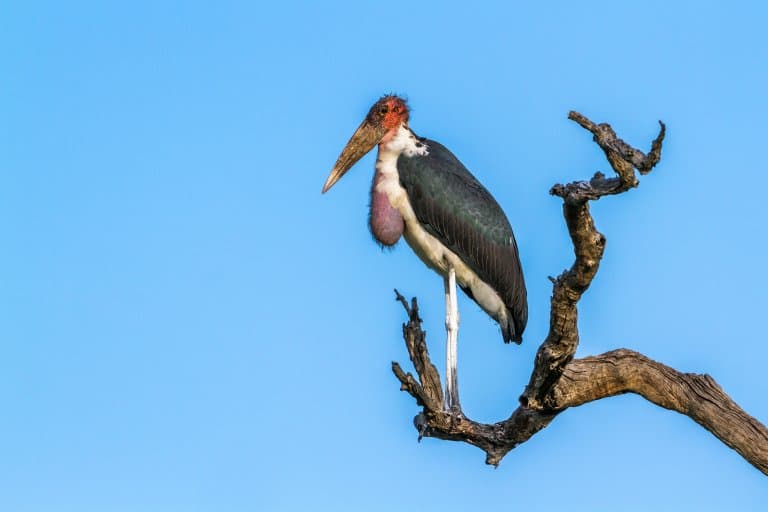
These are huge birds, which can stand up to 4ft 11, and have a wingspan of 2.5m (8ft 2) and weigh up to 5kg. Their enourmous bill averages 32cm (12.7 inches) in length.
3. There are so few left
This is one of the most endangered stork species in the world. The IUCN has them counted between 800 and 1,200 individuals remaining, and their populations are still decreasing.
Once commonly breeding all the way across Northern India and into Pakistan, through Myanmar, Thailand and Vietnam, they’re now only reproducing in two locations: one in Assam, and the other in North-eastern Cambodia.
Habitat destruction is their major threat, as their breeding grounds require certain specific qualities that people don’t particularly appreciate; namely, wetlands. These areas are commonly drained to make space for more people or farm animals, and this leaves the storks with very little space to make nest sites.
They’re also quite unpopular, on account of their frequenting rubbish piles and, well, their testicular appearance. 1
4. Neck scrotums
Since birds keep their genitals hidden away internally, some have developed analogues to show off as a symbol of their virility.
One of the characteristic features, especially in males of the species, is a familiar pink and wrinkled pouch, covered in sparse, fluffy down and swinging proudly under its chin.
What’s worse is that it’s connected to the left nostril, and can therefore be inflated for maximum effect. This ventilation also allows for a sort of resonant, guttural croak to emanate from the bird.
They also have one on the back of their neck, as if the front bag wasn’t enough.
This sac is better described in the Adjutant’s more populous African cousin, the Marabou stork, but the physiology and social role are the same. In the Greater adjutant, this pendulous accessory is swung back and forth as part of the mating display, usually while the owner is holding a large stick.
Notably, it’s not present in the smaller species, L. javanicus, and these birds are commonly considered “Lesser adjutants” because of it. 2 3
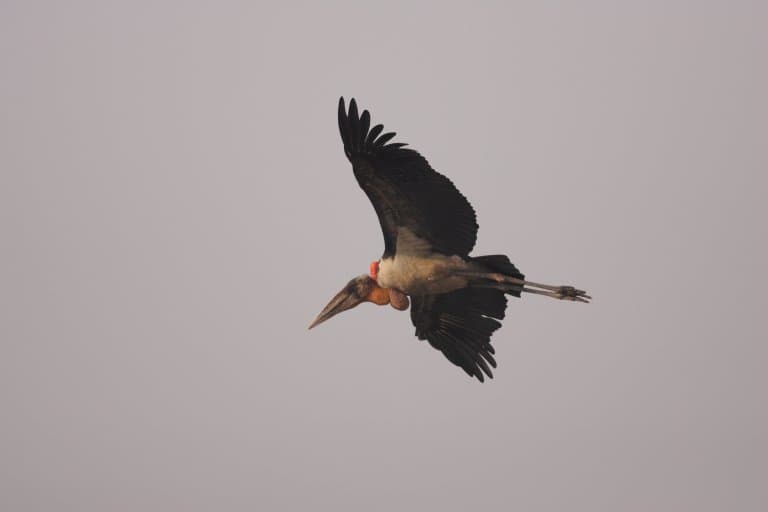
5. Their name is derived from their stiff “military” gait
I think we’ve covered plenty of the grotesque elements of this bird, but it wouldn’t be fair to overlook just how awesome they are.
The first thing to notice is their size. They’re around a meter and a half tall in many cases, far larger than a bipedal human child, and they walk with a sort of stiff formality that, while not technically graceful, is controlled and deliberate.
Despite eating poop, they give off an air of both pride and humility and are commonly found walking unafraid and inquisitively among busy streets, or sitting peacefully on railings or lamp posts.
The name comes from a military term, referring to an officer who assists a higher-up in the ranks.
And it’s appropriate, when you see these storks walking around with their hands behind their backs and their heads tall, taking it all in.
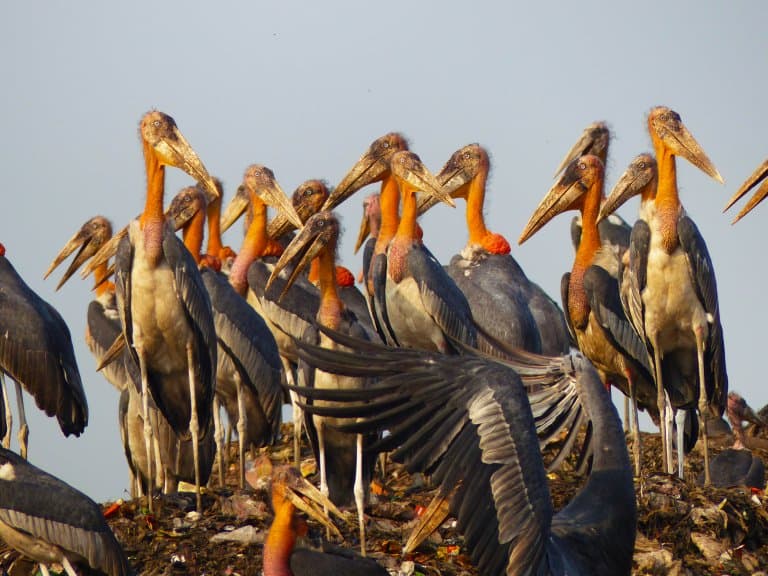
6. They’re nimble aviators
Despite their weighty mass, these huge birds aren’t as clumsy as many others when taking off. Their outstanding wingspan of over 2.5 meters lifts them fairly casually, if a little slowly from almost a standing start.
This is impressive for such a heavy bird, and many similar animals require a hill start, or even to wait for thermals to pull them up from a cliff Gyps vulture before they can reach soaring altitude.
And when they come in to land, these outstanding storks can land as effortlessly on the top of a slender light pole as they can on the grass.
7. While they’re up there, they soar
Since these birds occupy a similar niche as vultures in their range, it’s not uncommon to see them following a similar behavioural pattern.
Adjutants ride thermals, sometimes for hours and at chilly high altitudes, and often in vast groups of many tens, perhaps hundreds of individuals – a sight that would have been even more incredible just a few decades ago before their numbers dropped dramatically. 4
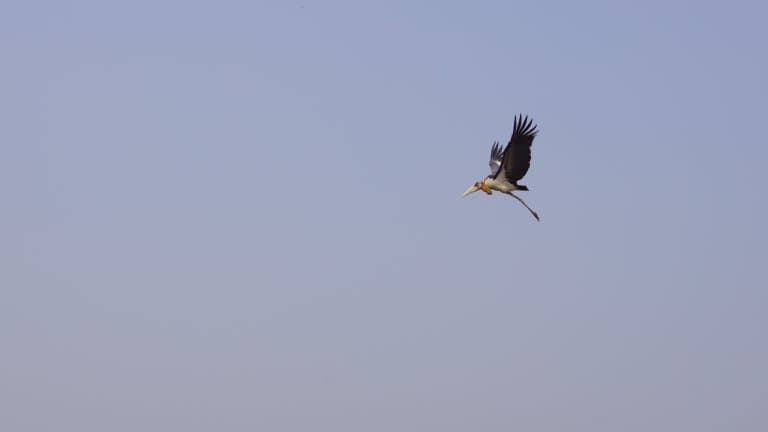
8. They used to be common in Calcutta
They were especially common in the city of Calcutta in the nineteenth century, where they were referred to as the “Calcutta adjutant” and incorporated in the city’s coat of arms.
In particular they were found around garbage dumps and landfills, where they will feed on any animal or human leftovers!
9. Their local name ‘hargila’, means bone swallower
The local name ‘hargila’ in Bengal and Assam means ‘bone swallower’, derived from the Sanskrit for “bone” and gila – “to swallow”.
This is in reference to their incredible digestive system of these large storks which allows them to eat and swallow bones.
10. Stork Sisters
Some of the conservation efforts of this species include a grassroots drive by a team of women known as the Hargilla Army, each member a ‘Hargilla Baido’, or ‘Stork Sister.’
These 70 local conservationists in Northeastern India are working to protect the species as a valuable addition to their ecosystem and a necessary component of the natural clean-up crew.
In Dadara and two nearby villages, Pasariya, and Singimari, they are protecting valuable wetland habitats for the bird, and by 2015, it was claimed that 550 of the remaining individuals were living in them. 5
Greater Adjutant Fact-File Summary
Scientific Classification
| Kingdom: | Animalia |
| Phylum: | Chordata |
| Class: | Aves |
| Order: | Ciconiiformes |
| Family: | Ciconiidae |
| Genus: | Leptoptilos |
| Species: | Leptoptilos Dubius |
Fact Sources & References
- “Greater Adjutant”, IUCN Red List.
- Hfffafjyoti Singha (1998), “Ecology, Biology and Ethology of Greater Adjutant Stork Leptoptiios dubius (Gmelin) in Assam, India”, Wildlife Science.
- Renu Tewari (2022), “Greater Adjutant showing neck pouch & breeding color”, Bird Forum.
- Collar, N.J (2014), “Greater Adjutant Leptoptilos dubius”, Data Zone.
- MOUSHUMI BASU (2016), “All-Women ‘Army’ Protecting Rare Bird in India”, National Geographic.
